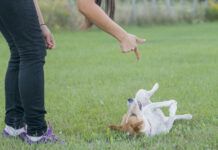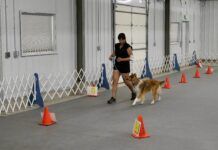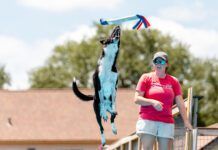[Updated February 5, 2019]
One of the many things I love about today’s dog training world is that now, thanks to our culture’s paradigm shift toward positive reinforcement-based training, a lot more people are having fun teaching their dogs to do tricks. Once a mere afterthought in training, fun is now taking center stage as more trainers offer classes in “just” tricks, and encourage their clients to get creative with the behaviors they teach their dogs. In fact, there are even canine titles to be earned in tricks! Kyra Sundance, a stunt dog trainer/performer and author, offers five levels of Trick Dog titles through her Do More With Your Dog program, from Novice Trick Dog to Trick Dog Champion.
We have gone far beyond the “Sit, Shake, Sit Pretty, Roll Over” list of basic tricks, although these are still favorites with many dog owners. Today’s trick-trained dog can play an electronic keyboard, roll himself up in a blanket, put bottles in a recycling bin, and much more. Here are some of my favorite creative tricks that you can teach your dog. All you need to get started are your dog, a clicker (or verbal marker), treats, and any props your chosen trick entails.
Leg Weaves
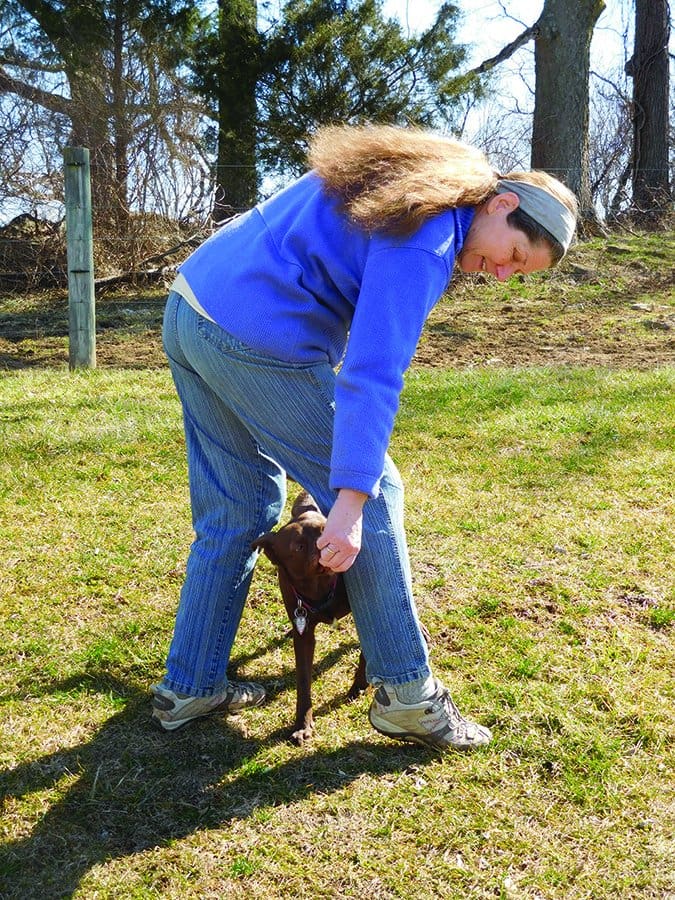
For this trick, your dog weaves in and out of your legs every time you take a step forward. No props are needed for this one, and it’s a pretty easy trick for most dogs.
– Start with your dog sitting at your left side. Put your right foot forward.
– To lure, put a treat in your right hand and offer it to your dog under your thigh, behind your right leg. As he moves toward the treat, pull it back away from him so he follows it under your leg. Click and treat. (He should move across in front of you.)
– Put your left foot forward and repeat the action with the treat in your left hand this time. Or, you can ask him to target to your hand or a target stick held behind your leg, rather than using a lure.
– If he’s hesitant to follow the lure or target under your leg, toss the treat behind you as he starts under, until he’s moving more easily – then have him follow the lure or target.
– As soon as he’s moving smoothly under your legs, add your cue, and fade the lure or target. Eventually you will only need to cue the first step – after that your steps forward become the cue for him to continue weaving. Look – you’re dancing with your dog!
If you want to use a target stick for this trick, teach your dog to target! See “Utilizing Target Training,” WDJ January 2007.
Check out this video by San Diego, California, trainer Emily Larlham, owner of Dogmantics dog training and the Kikopup Youtube channel, showing how she teaches a dog to do leg weaves.
Say Your Prayers
This trick is cute: On cue, your dog goes to a bench, sits, puts his paws up on the bench, then drops his nose between his paws as if he’s saying his prayers.
– Have your dog sit in front of his prayer bench. Encourage him to put his paws on the bench; he will probably stand up to do this. That’s okay! Click and treat when his paws are on the bench.
– While he is standing with his paws on the bench, ask him to sit. He will probably try to remove his paws from the bench in order to sit. That’s okay! Click and treat for any movement toward a sit before his paws come off the bench.
– Alternate repetitions of both behaviors (paws on the bench from a sit, and sit while standing with paws on the bench). As you gradually shape each behavior they will eventually meet in the middle and he will be able to sit with his paws on the bench.
– When he will remain seated with his paws on the bench, hold a treat in front of his nose with one hand to keep him in place while you move a second treat underneath and between his front legs with your other hand.
– Lure his nose down with your first treat until his nose reaches your second treat, then lure his nose down slightly between his front legs. Click (or use your verbal marker) and treat.
– When you can easily lure his nose between his legs, add your verbal cue, “Say your prayers!” and gradually lure less and less, until he can say his prayers on cue.
Pups in a Blanket
For this more challenging trick, your dog lies down on a blanket, grasps the corner of the blanket in his mouth, and rolls over to wrap himself up. For the best success, teach rolling over and blanket-grasping separately, then put them together.
Roll Over:
– Ask your dog to lie down. Kneel or squat next to your dog.
– Use a treat in your hand to encourage your dog to roll flat onto one side (if he is already rolled onto one hip be sure to continue in the same direction) by moving the lure in a “C” shape toward his ribcage, then up to his spine. Repeat until he easily moves into the flat-on-his-side position. (I call this position “Relax.”)
– From “Relax,” encourage your dog to turn tummy side up using your treat lure. Place the lure at the end of his nose and move it up in a half-circle above his head. As soon as he shifts so his legs lift off the floor ever so slightly, click and treat. Gradually increase the amount of the arc until he is turning onto his back, and then all the way over. Once the dog passes the point of equilibrium, gravity takes over and the roll just happens.
– Go slowly; some dogs get a little worried when they feel themselves rolling over. Make sure your dog is comfortable at each new step before asking him to roll a little farther.
Grasp the Blanket:
– Have your dog lie down on the blanket. If he already knows a “Take it!” cue, offer him the corner of the blanket and ask him to take it. If he doesn’t, encourage him to play with the corner of the blanket, then click and treat any time he puts his mouth on it.
– When he’ll grasp the blanket with his teeth, add your “Take it!” cue. Gradually increase duration until he is holding the blanket in his teeth for several seconds.
– Alternatively, you can fold a treat into the corner of the blanket and click and treat when he grabs it with his teeth. Add your cue, and gradually increase duration until he is holding the blanket in his teeth for several seconds.
Combine the Behaviors:
– When he knows both behaviors well, put them together. Start by having him lie down on the blanket.
– Give him your “Take it!” cue, and when he is holding the blanket in his teeth, cue him to “Roll Over.”
– If he keeps hold of the blanket and rolls over, click, treat and party!
– It is more likely that at first he will probably drop the blanket and roll over. Watch him closely, and click just before he drops the blanket. If he drops it before he rolls over at all, just try again.
– Repeat this step, gradually increasing duration of the blanket hold until he will keep it in his teeth while he rolls all the way over. Pup’s in a blanket!
6 More Dog Tricks!
1. Take a Bow: Use the food lure (or touch target) as if asking for a “down.” Move the food just a little at first, so only his front end lowers. Gradually move the treat lower and lower until the front end is all the way down but the hind end is still up.
2. Crawl: Have the dog lie down, then move the lure or target forward slowly, close to the ground, to encourage the dog to follow it without getting up.
3. Jump Over (or Through) My Arm(s): Kneel facing a wall, two feet away, with your dog on your left side. Touch the fingers of your left hand to the wall, arm low. Use the lure or target in your right hand to encourage him to jump over your arm. With your dog on your right side, switch arms and do it again.
4. Spin/Twirl: Move the lure or target in a slow circle at the dog’s nose level, so the dog can follow. Use different words for left- and right-hand circles.
5. Side Pass: With the dog standing in front of you, use a lure or target to keep her nose centered in front of you and slowly step sideways.
6. Dance: Hold the lure or target the height of the dog’s body length off the ground. When the dog stands on her hind legs, move the lure/target as if asking for a spin.
Other Trainer Favorites
Some of my trainer friends shared their favorite dog tricks with me:
Valerie Balwanz, PMCT, CPDT-KA Pampered Pets, Charlottesville, VA
Photo courtesy of Valerie Balwanz
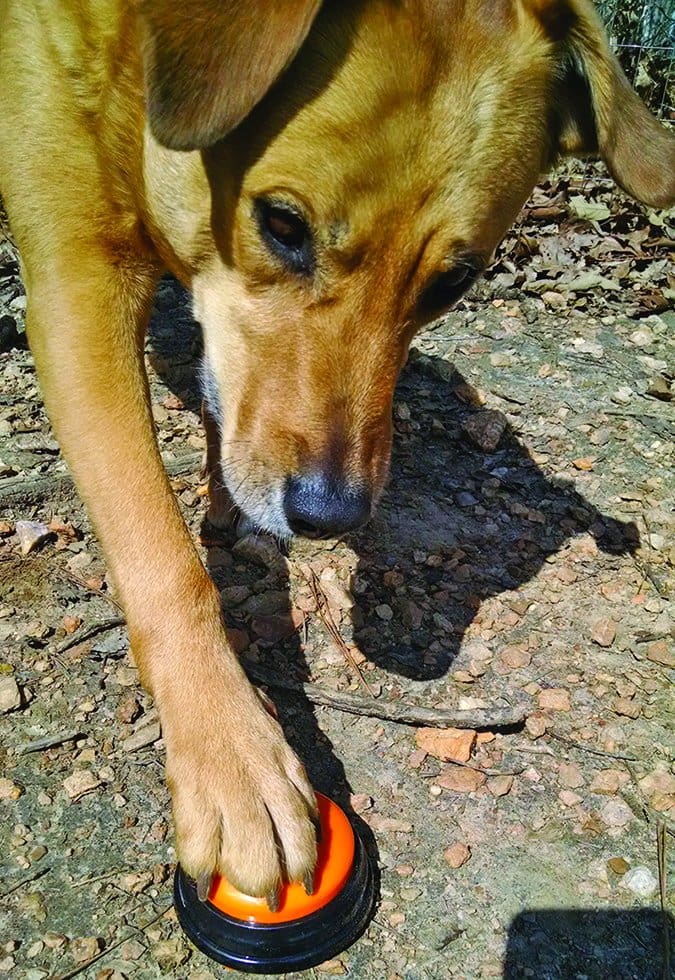
“My favorite thing to teach the dogs in my tricks class is to hit buzzers that make funny sounds with their paws. Some of the buzzers make animal sounds, mooing like a cow or crowing like a rooster. Others make cartoon-like ‘Boing!’ or honking sounds. Once the dogs have mastered this trick, the classroom explodes into a cacophony of amusing sounds. This gets everyone laughing.”
You can also do this trick using talking buttons, like the Staples “That Was Easy” Button.
Balwanz recommends using shaping to teach this trick. (See “Fun Training Techniques,” WDJ March 2006.) But first, make sure the dog isn’t concerned about the sound the buzzer makes. Push the buzzer, feed a treat. Repeat this several times and watch for signs of stress. For dogs who are concerned about the sound, use a push-on night light in place of the buzzer. Then start shaping:
– Click and treat for any movement toward the buzzer. This could include looking toward the buzzer, leaning toward the buzzer, or actually moving toward the buzzer.
– When you are starting to get consistent movement toward the buzzer, raise your criteria, and only click/treat for any foot movement toward the buzzer.
– When you are getting lots of foot movement, select which foot you want the dog to use and then only click/treat specific right- or left-foot movement toward the buzzer.
– When you are seeing consistent movement of your chosen foot, raise your criteria again, and click/treat for right-foot movements within six inches of the buzzer.
– Your next criteria might be to click/treat for right-foot movements within three inches of the buzzer.
– Then click/treat for right-foot movements within one inch of the buzzer.
– Then only click/treat for right-foot movements that touch the buzzer anywhere.
– Then only click/treat righ- foot movements that touch the buzzer on top.
– Finally, click and treat right-foot movements that touch the buzzer on top and are hard enough to make it make noise.
Once your dog performs this last step consistently, name the behavior (put it on cue). Balwanz asks her students to make up their own cue for this behavior. “My students understand that we always get behavior before we name behavior, so once their dog is hitting the buzzer, they can call it anything they like. This encourages them to be creative. I enjoy hearing the funny cues they invent!”
Following are links to various sources for buzzers and buttons. Some office supply stores sell “front desk” bells, which are also fun to use for this trick.
Animal sound buzzers are available here.
Get fun sound buzzers here.
Purchase talking buttons here.
Sharon Messersmith, Canine Valley Training Facility, Reading, PA
Photo courtesy of Sharon Messersmith

“My favorite trick to teach dogs to play is ‘Peek-a-Boo’ between the owner’s legs,” Messersmith says. “It gets the most reaction from kids and adults when I’m doing a therapy visit or just trying to make someone laugh.”
– Stand in front of the dog with your back to him, your feet wide enough apart so the dog can put his head through your legs. Hold a treat at the dog’s nose level in front of you to lure him through your legs. Make sure you only put it far enough so he comes through to his shoulders. As the dog is walking toward the treat, mark the behavior with a click or the word, “Yes,” and treat your dog.
– Repeat the first step until your dog starts to offer the behavior a few times. Then you can start to add the cue “Peek-a-Boo” as your dog is walking between your legs, but before you mark the behavior with a click or “Yes.”
– When your dog is reliably walking through your legs (eight out of 10 tries), begin to fade the lure. Stand in front of your dog with feet apart and say, “Peek-a-Boo.” When your dog starts to walk through your legs, click or say, “Yes” and feed a treat. If your dog doesn’t walk through your legs after being cued, wait three seconds, then lure him through.
– As you continue to practice this trick, your dog will need less of a lure. Continue to fade the lure until he will do Peek-a-Boo reliably on cue. Click and treat!
Jessica Ring, PMCT, My Fantastic Friend, Ellicott City, MD
“One of my favorite tricks is ‘Chill,’ in which the dog rests his chin on the ground or on some other designated surface such as someone’s lap,” Ring says. “This is a simple and great trick to teach a therapy dog, or one who is on crate rest. I taught it to my dog after he had hip replacement surgery. It’s useful in the car or to help a dog relax – and it’s also ridiculously adorable.”
To teach this trick, Ring also uses shaping:
– Start with the dog in the down position and wait for any tiny movement of the head, eyes, or ears toward the ground. Click and deliver the treat on the ground.
– Repeat several times, until you are sure your dog has caught on (you see him offering small but deliberate movement toward the ground), and then hold out for a slightly larger movement.
– Keep repeating this process over the course of multiple short sessions, until your dog is resting his chin on the ground.
– Once you get to the point where your dog’s chin is resting on the ground, click and treat after just a split second.
– After several repetitions, gradually build duration over time by waiting just a hair longer before clicking/treating. Be sure that you are clicking and treating frequently. If your dog seems to be getting frustrated or you are not clicking very frequently, back up a few steps and work there a bit longer before increasing your expectations.
Endless Possibilities
The tricks described here can get you started, and further possibilities are endless! Ask whether your local dog trainer teaches a trick class. Search Youtube for “dog tricks” to see more dogs doing more tricks than you ever thought possible. Check out Kyra Sundance’s books – 101 Dog Tricks: Step-By-Step Activities to Engage, Challenge, and Bond With Your Dog and 101 Dog Tricks, Kids Edition, both available from Dogwise.com. But most important, remember to have fun training your dog. If you do that . . . it’s all tricks!
Author Pat Miller, CBCC-KA, CPDT-KA, is WDJ’s Training Editor. She and her husband Paul and their four dogs live in Fairplay, Maryland, site of her Peaceable Paws training center, where Pat offers dog-training classes and courses for trainers. Miller is also the author of many books on positive training. Her two most recent books are Do Over Dogs: Give Your Dog a Second Chance at a First-Class Life, and How to Foster Dogs: From Homeless to Homeward Bound.


